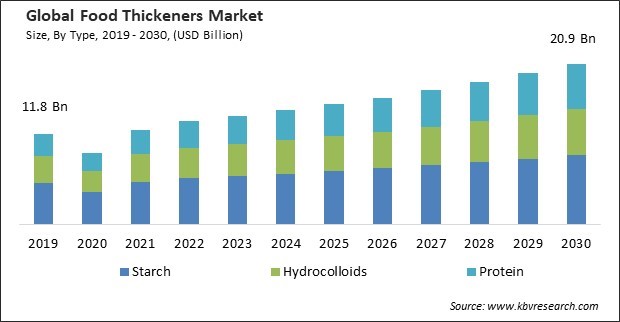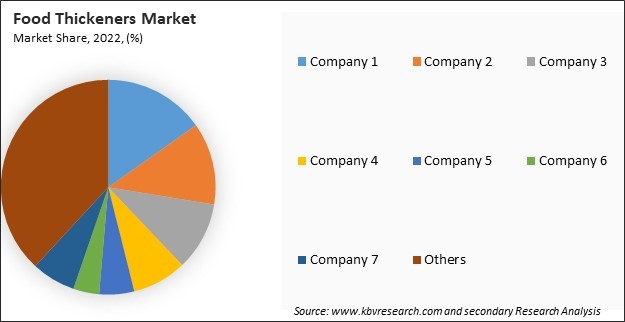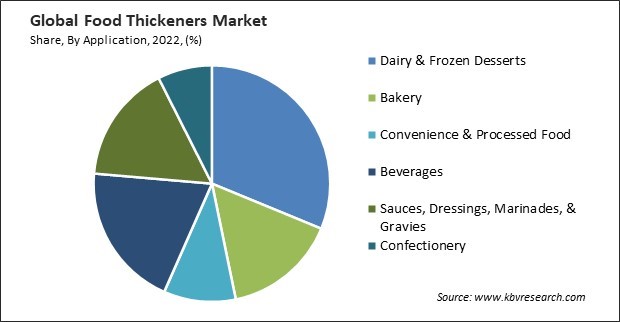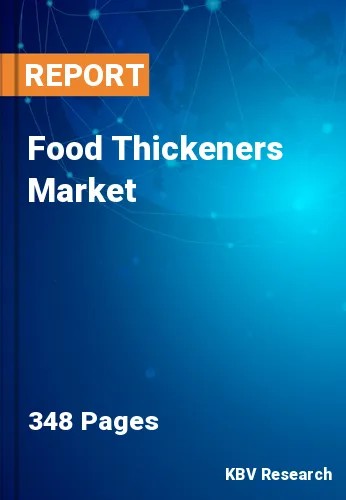The Global Food Thickeners Market size is expected to reach $20.9 billion by 2030, rising at a market growth of 5.8% CAGR during the forecast period. In the year 2022, the market attained a volume of 7,181.2 Kilo Tonnes, experiencing a growth of 5.6% (2019-2022).
Food thickeners play a crucial role in stabilizing coatings and fillings, ensuring that the visual appeal and quality of the confectionery product are maintained throughout its shelf life. Consequently, the confectionery segment captured $1,000.1 million revenue in the market in 2022. The confectionery segment benefits significantly from using food thickeners to achieve desirable textures and mouthfeel in various products. Certain food thickeners possess gelling properties that are particularly beneficial in producing jellies, gummies, and chewy candies. Thickeners contribute to forming a stable gel structure, providing the characteristic texture and mouthfeel associated with these confectionery items. Some of the factors impacting the market are Increasing demand for processed and convenience foods, Growing aging population and dietary needs and Fluctuations in the costs of raw materials.

The global rise in urbanization and busy lifestyles has escalated demand for processed and convenience foods. Food thickeners enhance these products' texture, stability, and overall quality, increasing their popularity among consumers seeking convenient meal solutions. Ready-to-eat and convenience meals have gained popularity due to their time-saving nature. The aging global population has led to an increased prevalence of conditions such as dysphagia, where individuals have difficulty swallowing. Food thickeners are essential in modifying the viscosity of liquids addressing dietary needs for those with swallowing difficulties. This demographic trend is boosting the food thickeners market, particularly in healthcare settings. Maintaining proper hydration is crucial for seniors' health, and many individuals may face challenges with standard liquid intake. Thickeners modify the consistency of liquids, including water, juice, and nutritional drinks, ensuring that seniors can stay hydrated while addressing swallowing difficulties. As a result of the growing aging population and dietary needs, the food thickeners market is anticipated to increase significantly.
The costs associated with raw materials, production processes, and transportation can be subject to fluctuations, impacting the overall cost of food thickeners. Economic factors, geopolitical events, and supply chain disruptions can introduce uncertainties that may affect pricing and profitability for manufacturers. Food and beverage manufacturers often work within predetermined budgets. Cost fluctuations in food thickeners can create budgetary constraints, limiting the flexibility of manufacturers to invest in premium or innovative thickeners that may be more costly. Cost fluctuations introduce uncertainty into suppliers' and end-users planning and forecasting efforts. This uncertainty makes it challenging for companies to make accurate predictions about future costs, production volumes, and pricing strategies, hindering effective business planning. Fluctuations in the costs of raw materials is a significant challenge that hampers the growth of food thickeners market.

The leading players in the market are competing with diverse innovative offerings to remain competitive in the market. The above illustration shows the percentage of revenue shared by some of the leading companies in the market. The leading players of the market are adopting various strategies in order to cater demand coming from the different industries. The key developmental strategies in the market are Acquisitions, and Partnerships & Collaborations.
By type, the food thickeners market is categorized into starch, hydrocolloids, and protein. In 2022, the starch segment held the highest revenue share in the food thickeners market. Starch boasts a range of functional properties that make it an ideal candidate for food thickening applications. Its ability to form gels, stabilize emulsions, and provide viscosity makes it versatile in creating various food products. Starch-based thickeners are employed in myriad applications, including sauces, soups, gravies, desserts, and bakery items, showcasing the adaptability and utility of starch-derived products. The increasing interest in plant-based diets and sustainable food practices has elevated the appeal of starch-derived thickeners. Starch, sourced from plants like corn and potatoes, provides an alternative to synthetic thickeners and animal-derived products.
Based on application, the food thickeners market is classified into dairy & frozen desserts, beverages, bakery, convenience & processed food, sauces, dressings, marinades, & gravies, and confectionery. The beverages segment acquired a substantial revenue share in the food thickeners market in 2022. Food thickeners allow for the creation of specialty beverages with unique textures and presentations. For example, thickeners can be used to develop bubble teas or boba drinks with chewy tapioca pearls, adding a distinctive and enjoyable element to the beverage. This innovation attracts consumers seeking diverse and novel drink experiences. As consumers become increasingly health-conscious, there is a demand for reduced-fat and low-calorie beverage options. Food thickeners play a crucial role in these formulations by providing the desired mouthfeel and texture even in products with lower fat content. This allows for the creation of healthier alternatives without sacrificing sensory appeal.

On the basis of source, the food thickeners market is divided into plant, animal, and microbe. In 2022, the plant segment dominated the food thickeners market with maximum revenue share. Increasing awareness of health and wellness has led consumers to seek plant-based alternatives. Plant-derived thickeners are often perceived as healthier options, aligning with consumer preferences for natural and nutritious ingredients. The rising popularity of vegan and vegetarian lifestyles has driven the demand for plant-based thickeners. These ingredients are crucial for formulating various vegan and vegetarian products, including plant-based milks, desserts, and meat alternatives. Plant-based thickeners are often associated with clean labels, as they are derived from natural sources and undergo minimal processing. This appeals to consumers seeking transparency in food labels and avoiding synthetic additives.
| Report Attribute | Details |
|---|---|
| Market size value in 2022 | USD 13.4 Billion |
| Market size forecast in 2030 | USD 20.9 Billion |
| Base Year | 2022 |
| Historical Period | 2019 to 2021 |
| Forecast Period | 2023 to 2030 |
| Revenue Growth Rate | CAGR of 5.8% from 2023 to 2030 |
| Number of Pages | 348 |
| Number of Table | 660 |
| Quantitative Data | Volume in Kilo Tonnes, Revenue in USD Billion, and CAGR from 2019 to 2030 |
| Report coverage | Market Trends, Revenue Estimation and Forecast, Segmentation Analysis, Regional and Country Breakdown, Market Share Analysis, Porter’s 5 Forces Analysis, Company Profiling, Companies Strategic Developments, SWOT Analysis, Winning Imperatives |
| Segments covered | Type, Source, Application, Region |
| Country scope |
|
| Companies Included | Cargill, Incorporated, Archer Daniels Midland Company, DuPont de Nemours, Inc., Kerry Group, Plc., Tate & Lyle Plc., Fuerst Day Lawson Ltd., Ingredion Incorporated, Darling Ingredients Inc., Ashland Inc. and CP Kelco U.S., Inc. |
| Growth Drivers |
|
| Restraints |
|
Region-wise, the food thickeners market is analysed across North America, Europe, Asia Pacific, and LAMEA. In 2022, the Europe region led the market by generating the highest revenue share. The processed food industry in Europe is significant, and food thickeners are widely used in formulating processed and convenience foods. European consumers are increasingly conscious of their health and wellness. The European region has a strong preference for natural and minimally processed ingredients. The popularity of dairy alternatives is growing in Europe, driven by lactose intolerance, veganism, and health-conscious consumers.
Free Valuable Insights: Global Food Thickeners Market size to reach USD 20.9 Billion by 2030
The market research report covers the analysis of key stake holders of the market. Key companies profiled in the report include Cargill, Incorporated, Archer Daniels Midland Company, DuPont de Nemours, Inc., Kerry Group, Plc., Tate & Lyle Plc., Fuerst Day Lawson Ltd., Ingredion Incorporated, Darling Ingredients Inc., Ashland Inc. and CP Kelco U.S., Inc.
By Type (Volume, Kilo Tonnes, USD Billion, 2019-2030)
By Application (Volume, Kilo Tonnes, USD Billion, 2019-2030)
By Source
By Geography (Volume, Kilo Tonnes, USD Billion, 2019-2030)
This Market size is expected to reach $20.9 billion by 2030.
Increasing demand for processed and convenience foods are driving the Market in coming years, however, Fluctuations in the costs of raw materials restraints the growth of the Market.
Cargill, Incorporated, Archer Daniels Midland Company, DuPont de Nemours, Inc., Kerry Group, Plc., Tate & Lyle Plc., Fuerst Day Lawson Ltd., Ingredion Incorporated, Darling Ingredients Inc., Ashland Inc. and CP Kelco U.S., Inc.
In the year 2022, the market attained a volume of 7,181.2 Kilo Tonnes, experiencing a growth of 5.6% (2019-2022).
The Dairy & Frozen Desserts segment is leading the Market, by Application in 2022; thereby, achieving a market value of $6.1 billion by 2030, growing at a CAGR of 4.9 % during the forecast period.
The Europe region dominated the Market, by Region in 2022, and would continue to be a dominant market till 2030; thereby, achieving a market value of $7.2 billion by 2030.
Our team of dedicated experts can provide you with attractive expansion opportunities for your business.

